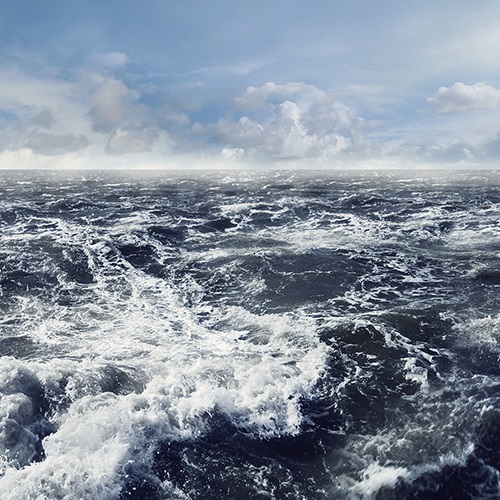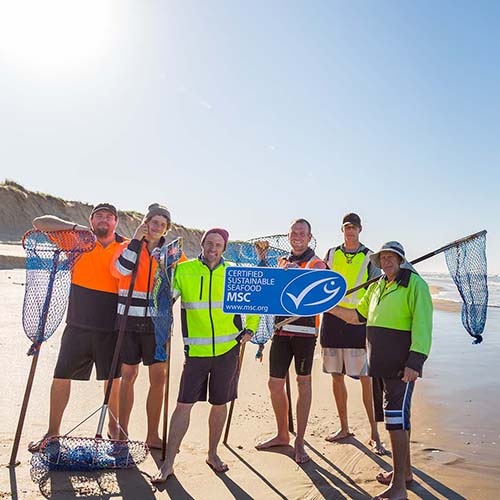Climate change is having a profound impact on our oceans and marine life. Its effects are changing the distribution of fish populations and their food.
How does climate change affect oceans and marine life?
93%
of heat accumulated in the Earth’s atmosphere is absorbed by the oceans
Oceans play a significant role in climate dynamics, absorbing 93% of heat that accumulates in the Earth’s atmosphere, and a quarter of the carbon dioxide (CO2) released from fossil fuels. The impacts of climate change on our oceans include shifts in temperature, acid levels, oxygen levels and ocean currents.
Given their importance to the planet, we must manage the oceans in a sustainable way. Changes to the ocean mean changes to fish stocks. To manage fishing, sustainably requires adapting to whatever issues climate change brings.
In the past 30 years, marine heatwaves are estimated to have increased by more than 50%. Globally, ocean temperatures are predicted to increase by 1-4°C by 2100.
These changes are impacting marine life. Sudden rises in temperature and acidification can lead to the loss of marine habitats and species. Shifting ocean currents and warming waters are changing the distribution of fish populations and altering the structure of ecosystems.
How does climate change affect fishing?
Climate change threatens fish stocks, but also creates new opportunities for fishing.
Areas in the Tropics are predicted to see declines of up to 40% in potential seafood catch by 2020.
In contrast, areas in higher latitudes, such as the North Atlantic and North Pacific, are seeing increases in the range of some fish species.
These changes bring challenges. To continue to fish sustainably requires adopting new ways of fishing. The fishing industry and governments have found it challenging to agree on how best to manage changing fish populations. It is even more challenging where fish are moving across international boundaries and where a reduction in catches is required.
If climate change affects fish, can I still eat it?
1 to 5 kg of
carbon produced per kilo of wild fish
Yes. Try to choose fish and seafood labelled with the blue fish tick. MSC certified fisheries are well managed and more prepared for environmental changes. These fisheries follow current scientific advice to ensure they catch fish sustainably.
Wild fish is a low carbon food
Additional good news is that fishing has less impact on the climate than the harvesting of other proteins. A study of greenhouse gas emissions of wild fisheries found that each kg of fish caught produces between one and five kilograms of carbon. By comparison, red meat production is estimated to range from 50 to 750 kilograms of carbon per kilogram of meat.
There is also evidence that sustainable fishing helps to reduce carbon emissions by increasing efficiency. For example, increased catches within Icelandic fisheries mean that fishing vessels now make shorter fishing trips, reducing their fuel use and carbon emissions as a result.
How do sustainable fisheries cope with climate change?
Sustainable fisheries that meet the MSC’s standard for sustainable fishing are well-managed and more prepared for climate change.
These fisheries have effective monitoring and management in place to reduce their impacts on the environment and only catch what is sustainable. Following advice from scientists, these fisheries have pre-agreed plans for responding to likely environmental changes.
These fisheries show that it is possible to balance economic and environmental priorities to safeguard our oceans and seafood supplies.
What happens when fisheries struggle to adapt to climate change?
As climate change can affect populations of fish in unexpected ways, even MSC certified fisheries can experience problems.
Here are three examples of fish populations affected by climate change:
Western Australia abalone
In 2011 a marine heatwave impacted the MSC certified Western Australian Abalone fishery.
Abalone was unable to escape the warmer waters and in the northern reaches of the Western Australian Abalone fishery, a 99% mortality rate was observed. There has been no recognisable recovery encountered nine years on and commercial fishing has ceased entirely.
Researchers are now looking to stimulate a recovery by bringing in abalone from hatcheries to give the population a boost. One day commercial fishing may once again return to this area of the fishery.
Find out more about marine heatwaves and the impact on the Western Australia Abalone fishery.
North East Atlantic mackerel
There has been a rapid change in Atlantic mackerel distribution since 2007. Stocks have moved northward as sea temperatures rise.
The change in the movement of mackerel has resulted in disputes between coastal states over how to share fishery resources. With fish moving across geo-political boundaries, there is a lack of agreement on how best to manage the stock.
With no result to disputes, MSC certification for North East Atlantic mackerel was suspended in March 2019. This suspension affects fisheries operating in eight countries.
The mackerel fisheries have committed to delivering an effective harvest strategy by mid-2020. The MSC is working with partners to support these efforts and encourage a resolution to the dispute.
North Sea cod
Recent declines in North Sea cod populations have been attributed in part to changing climate. This change has resulted in fewer juvenile cod surviving to adulthood. Having fewer adult fish has made sustainable fishing of the cod stock more difficult. Because of this problem, MSC certification of North Sea cod fisheries was suspended in September 2019.
The fisheries have responded to this disappointing news by committing to measures to rebuild cod stocks over the next five years.
What else can be done to protect fish populations?
Fisheries managers need to adopt more precautionary approaches to secure future populations of fish. But effective fisheries management also requires significant international cooperation by governments. International collaboration is a considerable challenge
for many countries balancing economic and environmental interests.
There has been some progress. For example, in July 2015 delegates from Canada, Denmark (for Greenland and the Faroe Islands), Norway, Russia, and the United States signed an agreement to prevent unregulated commercial fishing in high seas of the central Arctic Ocean.
Opinion: Climate change set to drive a profound difference in the fishing industry
Find out more

Oceans at risk
Oceans are essential to life.They provide our last major wild food source and livelihoods for many. Overfishing and climate change threaten ocean health.

Overfishing, illegal and destructive fishing
The MSC was formed to address the problem of overfishing. Our program works against illegal and destructive fishing practices.

The impact on communities
Fish is an important source of food and income for communities around the world. For many people, sustainable fishing is a necessity, not a luxury.
